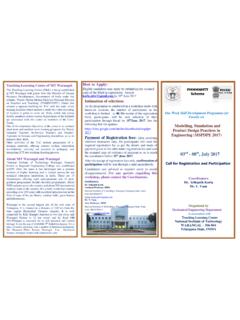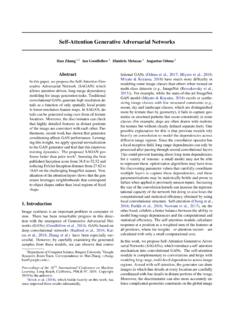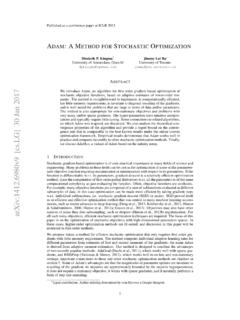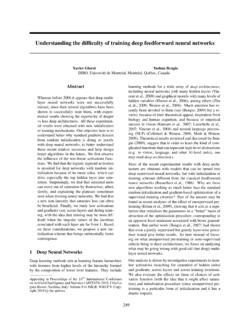Transcription of Syllabus AI and Artificial Intelligence and Machine …
1 Syllabus AI. and Certi cate Program in Arti cial Intelligence and Machine Learning A Practitioner's Approach (CAIML). ML. Jointly Organized by National Institute of Technology, Warangal E&ICT Academy About the Program PRACTITIONER'S APPROACH TO ARTIFICIAL Intelligence & Machine LEARNING. CAIML is an intensive application oriented, real-world scenario based program in AI & ML. CAIML is a 6 Months (Weekends), intensive skill oriented, practical training program required for building business models for analytics. It is designed to give the participant enough exposure to the variety of applications that can be built using techniques covered under this program. This course is designed for the experienced professionals from variety of IT backgrounds. No prior knowledge of statistics or modeling is assumed. OBJECTIVES. Acquire advanced Data Analysis skills. Stay Industry relevant and grow in your career. Create AI/ML solutions for various business problems.
2 Build and deploy production grade AI/ML applications. Apply AI/ML methods, techniques and tools immediatel COVERAGE and DURATION. Business Case Studies Foundations of AI/ML About the Program Data Visualization 10% 7%. 5% Data Management 8%. 20%. Arti cial Intelligence 10% Statistical Thinking 20% 20%. Machine Learning Predictive Analytics Module 1: Foundations of AI and ML. AI a multidisciplinary eld that requires a range of skills in statistics, mathematics, predictive modeling and business analysis. An AI professional should feel at ease to build the algorithms necessary, work with various data sources (often in disparate forms) and an innate ability to ask the right questions and nd the right answer. This module helps layout the canvas on which the rest of the modules are built. Unit 1: Introduction to Data Science and AI & ML. Data Science, AI & ML. Use Cases in Business and Scope Scienti c Method Modeling Concepts CRISP-DM Method Unit 2: R Essentials (Tutorial).
3 Programming Commands and Syntax Packages and Libraries Introduction to Data Types Data Structures in R - Vectors, Matrices, Arrays, Lists, Factors, Data Frames Importing and Exporting Data. Control structures and Functions Foundations of AI and ML. Descriptive Statistics Data exploration (histograms, bar chart, box plot, line graph, scatter plot). Qualitative and Quantitative Data Measure of Central Tendency (Mean, Median and Mode), Measure of Positions (Quartiles, Deciles, Percentiles and Quantiles), Measure of Dispersion (Range, Median, Absolute deviation about median, Variance and Standard deviation), Anscombe's quartet Other Measures: Quartile and Percentile, Interquartile Range Unit 3: Statistical Analysis Initial Data Analysis Relationship between attributes: Covariance, Correlation Coef cient, Chi Square Measure of Distribution (Skewness and Kurtosis), Box and Whisker Plot (Box Plot and its parts, Using Box Plots to compare distribution) and other statistical graphs Probability Probability (Joint, marginal and conditional probabilities).
4 Probability distributions (Continuous and Discrete). Density Functions and Cumulative functions Module 2: Data Management This is foundational to Data Scientists. This requires a nontrivial understanding of the real-world problems. It involves judgments such as those about the relevance and representativeness of the data. This module helps participants to have a good understanding of the methods, methodologies and techniques from the basics of statistics and probability obtain supporting evidence through data, isolate or identify factors to construct models that can uncover relationships and variation in processes. Unit 3: Data Acquisition Gather information from different sources. Internal systems and External systems. Web APIs, Open Data Sources, Data APIs, Web Scrapping Relational Database access (queries) to process/access data. Unit 4: Data Pre-processing and Preparation Data Munging, Wrangling Plyr packages Cast/Melt Unit 5: Data Quality and Transformation Data imputation Data Transformation (minmax, log transform, z-score transform etc.)
5 ,). Binning, Classing and Standardization. Outlier/Noise& Anomalies Unit 6: Handling Text Data Data Management Bag-of-words Regular Expressions Sentence Splitting and Tokenization Punctuations and Stop words, Incorrect spellings Properties of words and Word cloud Lemmatization and Term-Document TxD computation Sentiment Analysis (Case Study). Unit 7: Principles of Big Data Introduction to Big Data Challenges of processing Big Data (Volume, Velocity and Variety perspective). Use Cases Unit 8: Big Data Frameworks Hadoop, Spark and NoSQL. Processing, Storage andProgramming Framework Hadoop eco-system Components and their functions Essential Algorithms (Word count, Page Rank, IT-IDF). Spark: RDDs, Streaming and Spark ML. NoSQL concepts (CAP, ACID, NoSQL types). Module 3: Statistical Decision Making This is foundational to Data Scientists. This requires a nontrivial understanding of the real-world problems. It involves judgments such as those about the relevance and representativeness of the data.
6 This module helps participants to have a good understanding of the methods, methodologies and techniques from the basics of statistics and probability obtain supporting evidence through data, isolate or identify factors to construct models that can uncover relationships and variation in processes. Unit 9: Data Visualization Unit 11: Inferential Statistics Visualizing and Communicating clearly and effectively Develop an intuition how to understand the data, about the patterns we nd in data is a key skill for a attributes, distributions successful data professional. This module focuses on Procedure for statistical testing, etc. the design and implementation of complementary Test of Hypothesis (Concept of Hypothesis visual and verbal representations of patterns and testing, Null Hypothesis and Alternative analyses in order to convey ndings, answer questions, Hypothesis). drive decisions, and provide persuasive evidence Cross Tabulations (Contingency table and their supported by data.)
7 Use, Chi-Square test, Fisher's exact test), One Sample t test (Concept, Assumptions, Science of Visualization Hypothesis, Veri cation of assumptions, Visualization Periodic Table Performing the test and interpretation of results). Aesthetics and Story telling Independent Samples t test Concepts of measurement - scales of measurement Statistical Decision Making Paired Samples t test Design of data collection formats with illustration One way ANOVA (Post hoc tests: Fisher's LSD, Principles of data visualization - different methods Tukey's HSD). of presenting data in business analytics. z-test and F-test Concepts of Size, Shape, Color Various Visualization types Bubble charts Geo-maps (Chlorpeths). Gauge charts Tree map Heat map Motion charts Force Directed Charts etc., Unit 10: Sampling and Estimation Sample versus population Sample techniques (simple, strati ed, clustered, random). Sampling Distributions Parameter Estimation Unbalanced data treatment Module 4: Predictive Analytics Predictive analytics is an area of statistics that deals with extracting information from data and using it to predict trends and behavior patterns.
8 Predicting an outcome, predicting counts, predicting a value - all these have immumerable use cases in CRM, Fraud detection, Portfolio Management, Sales and Marketing. Predictic Analytics is approached from Regression (glm) and Time Series models in this module. Unit 12: Linear Regression Regression basics: Relationship between attributes using Covariance and Correlation Relationship between multiple variables: Regression (Linear, Multivariate) in prediction. Residual Analysis Identifying signi cant features, feature reduction using AIC, multi-collinearity Non-normality and Heteroscedasticity Hypothesis testing of Regression Model Con dence intervals of Slope R-square and goodness of t In uential Observations Leverage Unit 13: Multiple Linear Regression Polynomial Regression Regularization methods Lasso, Ridge and Elastic nets Categorical Variables in Regression Predictive Analytics . Unit 14: Non-Linear Regression Logit function and interpretation Types of error measures (ROCR).
9 Logistic Regression in classi cation Unit 15: Forecasting models Trend analysis Cyclical and Seasonal analysis Smoothing; Moving averages; Box-Jenkins, Holt-winters, Auto-correlation; ARIMA. Examples: Applications of Time Series in nancial markets Module 5: Machine Learning Predictive analytics is an area of statistics that deals with extracting information from data and using it to predict trends and behavior patterns. Predicting an outcome, predicting counts, predicting a value - all these have immumerable use cases in CRM, Fraud detection, Portfolio Management, Sales and Marketing. Predictic Analytics is approached from Regression (glm) and Time Series models in this module. Unit 16: Foundations for ML. ML Techniques overview Validation Techniques (Cross-Validations). Feature Reduction/Dimensionality reduction Principal components analysis (Eigen values, Eigen vectors, Orthogonality). Unit 17: Clustering Distance measures Different clustering methods (Distance, Density, Hierarchical).
10 Iterative distance-based clustering;. Dealing with continuous, categorical values in K-Means Constructing a hierarchical cluster K-Medoids, k-Mode and density-based clustering Measures of quality of clustering Unit 18: Classi cation Na ve Bayes Classi er Model Assumptions, Probability estimation Required data processing M-estimates, Feature selection: Mutual information Classi er K-Nearest Neighbors Computational geometry; Voronoi Diagrams; Delaunay Triangulations K-Nearest Neighbor algorithm ; Wilson editing and triangulations Aspects to consider while designing K-Nearest Neighbor Support Vector Machines Machine Learning Linear learning machines and Kernel space, Making Kernels and working in feature space SVM for classi cation and regression problems. Decision Trees ID4, , CART. Ensembles methods Bagging & boosting and its impact on bias and variance boosting Random forest Gradient Boosting Machines and XGBoost Unit 19: Association Rule mining The applications of Association Rule Mining: Market Basket, Recommendation Engines, etc.






